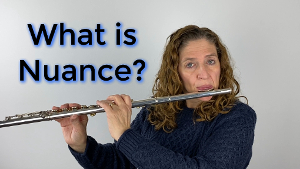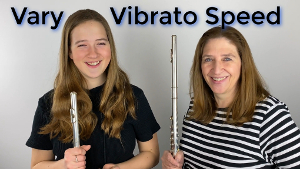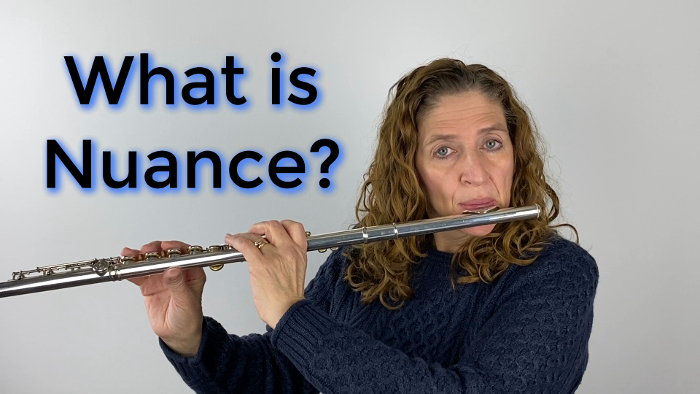Have you ever wondered what making good music is really all about? What makes those professionals have that extra something special in their music that is missing in others?
That something extra that they have is called nuance. A nuanced performance has special meaning that the performer is expressing to the listener.
Nuance is the meaning given to a musical passage by the performer. It is expressed differently by each musician.
But what does nuance really mean? Nuance is one of those tricky little words such as support that’s thrown out into music circles, and we all think, oh, yes, I know exactly what that means. But I think for a lot of people, they have only a vague idea of what that means.
How Do We Add Nuance?
Let’s talk about that idea. Nuance is something that’s not just a flute thing. It is something musicians and non-musicians talk about. When you refer to a topic of conversation as nuanced, what you are saying is that the subject under discussion has multiple meanings or interpretations. That is sort of what we mean when we talk about nuance in music. We are saying that I may give the music a different meaning than you give to the same piece. That is, I emphasize certain parts of the music that I deem more important. Whereas you emphasize different parts that you deem more important.
I think it’s like saying, “The boy went on a walk” and then someone else would say “The boy went on a walk,” meaning there was something going on in that walk or the boy, a specific kid went on a walk. You can emphasize something different, and it gives a slightly different, more subtle meaning to the sentence. That’s what we want to do with music.
Give More Weight
Now I’ll do that in a phrase, but I might decide this time when I play, I will give one note a particular meaning. How am I going to give that note meaning? Well one of the ways is to give a note in the phrase a little bit more weight than the other notes in the phrase. What does weight mean? In plain English weight means to hold a note just a little bit longer than other notes. Once you know this piece of information, then listen to some of your favorite solos performed by the great flutists and determine where they are giving weight in a particular phrase.
Play a phrase from the slow movement of your solo. Listen to a couple different recordings of this solo and listen to the weight put on certain notes in the phrase. Then practice doing what you heard. Play that phrase a couple different times imitating each of those performers. When you begin to hear this phrase, then try on your own to determine what you like. Make that phrase your own.
Change Color
Nuance can incorporate color changes as well. With color, we’re talking about your tone color. How can we change tone? Your tone has many different colors to explore. You can play a woody sound such as the sound a Baroque flute would make. Or you can play a 21st century dark edgy sound. I like to experiment with colors to see what I might like in a phrase. Feel free to take that same phrase you were just working on change that color a few times to see what you might like best.
Vary Vibrato Speed
What else can we do to effect nuance? We can vary vibrato speed. Vibrato speed is something that I think we do not use often enough to give us different color changes. I can use a slower vibrato or no vibrato to give a phrase a completely different sound altogether. Slow down your vibrato to sound woodier. Speed up your vibrato to sound more intense.
So, use all the tools you have available, weight on the notes, color changes and vibrato speed, and that all gives you the idea of nuance.
Now, if you have never experimented with nuance, then just take a phrase, and begin by just putting weight on different notes. As you explore and change, listen for what speaks to you as something important. Then vary the color. Start off woody, then end edgy. Next keep it woody all the way through. Try to give it an edge at the beginning, then go to wood. Finally, experiment with vibrato.
You can use the same phrase and change it over and over. Eventually you will see and hear what sounds good to you, what is important. This gives it meaning – more to the point it gives it your meaning. Not mine.
When I teach students, I teach them basically my meaning. But eventually I want them to come up with their own interpretation. I want them to have an idea of what they think the music is saying.
That is nuance in a nutshell. It is giving meaning to notes – giving your meaning to those notes.
Have fun!
DoctorFlute
Watch me demonstrate this:

Varying Your Vibrato with Speed with 14-Year-Old Student Allegra – FluteTips 124

Does the Cut of Your Lip Plate Make a Difference on a Professional Gold Flute? FCNY Sponsored

